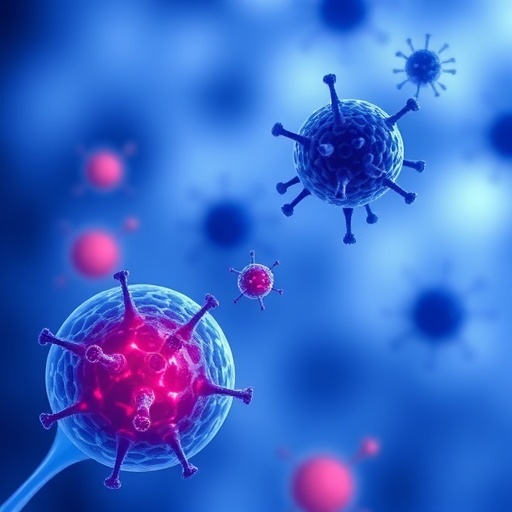In a groundbreaking study published in the Journal of Biomedical Science, researchers Chang, Chen, and Chen explore the intricate role of Cathepsin S in the regulation of interleukin-7-mediated anti-tumor immunity, uncovering its potential as a targeted therapy against oral cancer. This innovative research delves into the underlying mechanisms of immune response activation and the therapeutic implications that could revolutionize cancer treatment strategies. By focusing on the interplay between Cathepsin S and interleukin-7, this team sheds light on previously unexplored pathways that could enhance the efficacy of immunotherapy in combating oral cancer.
Oral cancer remains a significant global health concern, with rising incidence rates and limited therapeutic options for patients in advanced stages of the disease. Traditional treatments, including surgery, radiation, and chemotherapy, often fall short, highlighting an urgent need for novel approaches that effectively harness the immune system’s power. The current research introduces a promising avenue, indicating that manipulating immune regulatory mechanisms could optimize anti-tumor responses and provide new hope for individuals afflicted by this debilitating condition.
Cathepsin S, a lysosomal cysteine protease, has garnered attention due to its multifaceted role in both immune regulation and tumor progression. Historically, this enzyme has been implicated in various stages of cancer development, including metastasis and immune evasion. The authors of the study have meticulously examined how Cathepsin S interacts with interleukin-7, a cytokine critical for T cell homeostasis and expansion, particularly in the context of immune responses against tumors. Their findings suggest that Cathepsin S may serve as a key regulatory player, with implications that extend far beyond basic science.
Utilizing advanced experimental models, the research team established the connection between Cathepsin S and the modulation of interleukin-7 signaling pathways. By silencing Cathepsin S expression in vitro, they observed a significant alteration in the activation of T cells, an essential component of the adaptive immune system. This pivotal finding demonstrates that Cathepsin S not only facilitates a more robust immune response but may also help mitigate the suppressive tumor microenvironment often found in oral cancers.
Moreover, the study highlights that enhanced interleukin-7 signaling, mediated through the regulation of Cathepsin S, could lead to an increased proliferation of cytotoxic T lymphocytes, which are vital for targeting and eradicating cancer cells. The researchers emphasize that this relationship presents a unique opportunity for therapeutic intervention—if Cathepsin S can be appropriately modulated, it may enable the enhancement of interleukin-7-driven T cell responses in clinical settings.
Critically, the authors also discuss potential implications for combination therapies that leverage the findings of their research. Current strategies that utilize interleukin-7 in the treatment of cancers could be optimized through the incorporation of Cathepsin S targeting. Such an approach could lead to a synergistic effect, increasing the potency of immunotherapies and offering significant improvements in patient outcomes. The dynamics of combining targeted therapy with traditional modalities pave the way for an integrated cancer treatment paradigm that embraces both local and systemic approaches.
As researchers continue to uncover the complexities of immune regulation within the tumor microenvironment, the role of proteolytic enzymes like Cathepsin S cannot be underestimated. Their findings prompt a reevaluation of existing therapeutic frameworks, suggesting that future research should focus on understanding how to manipulate these enzymes to achieve more effective immune-mediated tumor rejection.
The potential real-world applications of this research are vast. As they seek to transition from bench to bedside, the team is optimistic that their findings may contribute to the development of more precise and personalized therapeutic strategies. By tailoring treatments that specifically target the interactions between Cathepsin S and interleukin-7, oncologists may soon have the tools necessary to improve prognosis and quality of life for patients battling oral cancer.
This important work not only highlights the intricacies of immune regulation but also underscores the potential of proteolytic enzymes as therapeutic targets in cancer biology. The collaboration between basic scientists and clinical researchers will be crucial to translating these findings into viable treatment options that can be seamlessly integrated into current oncological practices.
The future of cancer immunotherapy is bright, particularly as researchers like Chang, Chen, and Chen introduce innovative concepts that could reshape our understanding of tumor biology. Their commitment to unraveling the complexities of immune interactions sets the stage for an exciting new era of cancer treatment, one where patients may benefit from more effective therapies that harness the body’s natural defenses. As we anticipate further developments stemming from this research, the scientific community is urged to explore the myriad ways in which these findings can augment existing therapeutic strategies and foster novel treatment paradigms.
The implications of manipulating Cathepsin S and interleukin-7 signaling extend beyond oral cancer, potentially influencing other forms of malignancies. As ongoing studies investigate these relationships across various cancer types, we may soon witness a paradigm shift in how we view cancer therapies, steering toward more effective, immune-mediated approaches. The groundwork laid by this research serves as a beacon for future investigations aimed at refining immune activation strategies, paving the way for a broader arsenal in the fight against cancer.
In conclusion, the study published by Chang et al. marks a significant contribution to the field of cancer immunology, emphasizing the critical interplay between Cathepsin S and interleukin-7. As we move forward, it is imperative that continued research focuses on elucidating these complex mechanisms, fostering the development of targeted therapies that exploit our immune system’s intrinsic capabilities. In the battle against oral cancer and beyond, the insights gleaned from this research may very well be the catalyst for transformative change in oncological therapies.
Subject of Research: Regulation of Cathepsin S in interleukin-7-mediated anti-tumor immunity and its potential targeting against oral cancer.
Article Title: Unraveling Cathepsin S regulation in interleukin-7-mediated anti-tumor immunity reveals its targeting potential against oral cancer.
Article References:
Chang, YC., Chen, SJ., Chen, SH. et al. Unraveling Cathepsin S regulation in interleukin-7-mediated anti-tumor immunity reveals its targeting potential against oral cancer.
J Biomed Sci 32, 69 (2025). https://doi.org/10.1186/s12929-025-01154-6
Image Credits: AI Generated
DOI: https://doi.org/10.1186/s12929-025-01154-6
Keywords: Immunotherapy, Cathepsin S, interleukin-7, oral cancer, cancer biology, T cell response, targeted therapy, tumor microenvironment.
Tags: cancer treatment innovationsCathepsin S targeted therapyenhancing anti-tumor immunityimmune regulation in tumorsimmune system manipulation in cancerinterleukin-7 immune responselysosomal cysteine protease in cancernovel approaches to oral canceroral cancer immunotherapyovercoming traditional cancer treatmentsrising incidence of oral cancertherapeutic implications of Cathepsin S





